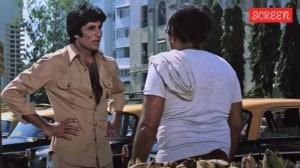How Rahul Bajaj and Bajaj Chetak beat Government restrictions, legal challenges by competitors
After the success of Bajaj scooters, Italian automobile manufacturer Piaggio accused Bajaj Auto of “misappropriating the design of Vespa” and continuing to manufacture the two-wheelers even after the end of the contract in 1971.
 In the late 1950s, when Rahul Bajaj was doing his BA (Economics) from St Stephens College in Delhi, he would ride a Vespa, the Italian scooter manufactured by Piaggio which was popular in the US and Europe and was being assembled and sold in India by a few licensees. (Source: Bajaj Heritage)
In the late 1950s, when Rahul Bajaj was doing his BA (Economics) from St Stephens College in Delhi, he would ride a Vespa, the Italian scooter manufactured by Piaggio which was popular in the US and Europe and was being assembled and sold in India by a few licensees. (Source: Bajaj Heritage)Rahul Bajaj was 34 when Kamalnayan Bajaj passed away in 1972 leaving the responsibility of running the industrial conglomerate on his young shoulders. In the same year, he launched three new products, including Bajaj Chetak, a scooter that propelled the company—Bajaj Auto—to national and international success.
In the late 1950s, when Rahul Bajaj was doing his BA (Economics) from St Stephens College in Delhi, he would ride a Vespa, the Italian scooter manufactured by Piaggio which was popular in the US and Europe and was being assembled and sold in India by a few licensees.
Among the Indian firms that had tied up with Piaggio to assemble Vespa was the Bajaj Group. In 1960, Bajaj Auto had entered into a contract with Piaggio to produce Vespa 150 Gran Sport VS 5 in India. In April 1971 this association abruptly ended when the Indira Gandhi government refused permission to continue the international collaboration.
 Among the Indian firms that had tied up with Piaggio to assemble Vespa was the Bajaj Group. (Source: Bajaj Heritage)
Among the Indian firms that had tied up with Piaggio to assemble Vespa was the Bajaj Group. (Source: Bajaj Heritage)
Having the ability and infrastructure to produce scooters, Bajaj Auto continued to produce them and launched three models—Bajaj Chetak, Bajaj 150 and Bajaj Super—in quick succession. The design of all three was based on Vespa scooters it produced for Piaggio.
Of the three, Chetak became a huge success. With limited supply due to the government capping, there was a long waiting period for Bajaj’s scooters. Prospective buyers had to wait for months and even years before they could take the scooter home.
Business author Gita Piramal says the scooter became popular and a flourishing black market developed. A customer fortunate enough to be allotted a Chetak could sell it the next moment at double the price. Dealers of the scooters could charge a huge premium unofficially for those who did not want to wait for so long.
Another shortcut to buying Chetak was to shell out foreign currency. “The Chetak was available against payment of elusive foreign exchange. The waiting list was not so long, and delivery was possible within a month but was possible for only those who had a ‘foreign connection’,” writes Gautam Sen in The Automobile: An Indian Love Affair.
 Bajaj Auto ran ads like these adorning the back cover of Time magazine between 1977 and 1979.
Bajaj Auto ran ads like these adorning the back cover of Time magazine between 1977 and 1979.
Rahul Bajaj wasn’t content in selling his scooters in India alone and it could manufacture more Chetaks than the government allowed it to sell, he started exporting them to Europe and America, although the numbers remained small. In 1981, Bajaj Auto had earned Rs 13.2 crore by way of exports of its scooters. Around the same time, it also ran an aggressive advertisement campaign in Time magazine dubbing itself as “one of the two largest scooter manufacturers of the world”.
Peeved, Piaggio accused Bajaj of “misappropriating the design of Vespa” and continuing to manufacture and sell the vehicle even after the end of the contract in 1971. Bajaj hired renowned law firm Baker-Mckenzie to defend it by shelling out $1 dollars and argued that it had the right to use the designs even after the expiry of the contract.
“Bajaj maintains it tendered the plans, but Piaggio allowed it to keep them. More importantly, Bajaj claims that the last agreement between the parties was executed with the express understanding that Bajaj’s right to produce these vehicles would survive the license agreement,” reads the June 1982 judgment of the California District Court which dismissed the case by Piaggio for lack of jurisdiction.
A few years later, the Indian government relaxed the constraints in the foreign investment in the two-wheeler industry and Piaggio returned to India by partnering with LML (Lohia Machinery) and Andhra Pradesh Scooters to sell Vespa in India.
The government’s decision to allow Piaggio back into India enraged Bajaj.
“Piaggio came here claiming they had better technology, a better vehicle and a better deal for the Indian customer. If they were so much better than us, they could have easily beaten us in America and Germany. Why did they take recourse to the courts? My anger was directed against the government of India for allowing them to enter again. It made my blood boil,” Bajaj was quoted as saying in Piramal’s book Business Maharajas.












